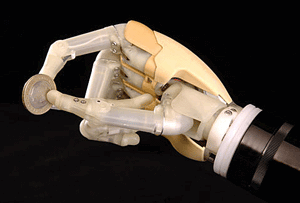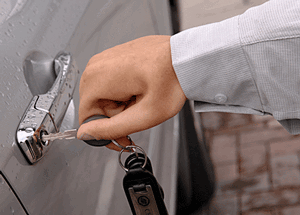Bionics, Illustrated by a Bionic Hand
(a bionic hand which is considered a next-generation prosthetic device which appeals to both patients and health care professionals)
Touch Bionics, an Edinburgh, Scotland-based company, has announced the "first commercially available bionic hand"
Touch Bionics announced Tuesday (July 17, 2007) what it calls the world's first commercially available bionic hand, a prosthetic hand that moves more naturally than traditional prostheses and can hold awkward or delicate objects.

Touch Bionics is a leading developer of advanced upper-limb prosthetics (ULP). One of the two products now commercially available from the company, the i-LIMB Hand™, is a first-to-market prosthetic device with five individually powered digits.
This replacement hand looks and acts like a real human hand and represents a generational advance in bionics and patient care.
The Touch Bionics i-LIMB Hand was developed using leading-edge mechanical engineering techniques and is manufactured using high-strength plastics.
The result is a next-generation prosthetic device that is lightweight, robust, and highly appealing to both patients and health care professionals.
This bionic hand is not like other prostheses which is available to most users
While most prostheses today can open and close, allowing people to grasp some items, they lack the detailed movements of a natural hand. The i-Limb Hand gets one step closer to that natural movement, with motors in each finger that make it possible to move individual fingers and form several different grips.
The Edinburgh, Scotland-based company also announced partial hand prostheses, called ProDigits. ProDigits can replace individual fingers or parts of a hand.
For most amputee patients, the brain still thinks the hand is there, according to Touch Bionics CEO Stuart Mead, so they are capable of moving a hand; if only there were a hand to move.
The muscles that would normally move the hand still behave in the same way as if the hand were there, Mead said.
The i-Limb works by detecting electrical signals triggered by the contraction of the same muscles used to control any normal hand. Those signals are picked up by electrodes on the surface of the skin and trigger movement in the hand or fingers.
This same system, called myoelectric control, is used in many other prostheses. So people who have used other myoelectric prosthetic hands are able to learn to use an i-Limb Hand quickly.
The modular construction of the i-LIMB Hand means that each individually powered finger can be quickly removed by simply removing one screw. This means that a prosthetist can easily swap out fingers that require servicing and patients can return to their everyday lives after a short clinic visit.
Traditional devices would have to be returned to the manufacturer, often leaving the patient without a hand for many weeks.
This bionic hand has a variety of grips and functions
The i-Limb can form different types of grips: a power grip, which looks like a fist; a key grip, where the thumb meets with the middle of the index finger, as when turning a key to turn on a car; and a pincer grip, where the thumb and fingertips meet together to hold a small object.

The i-Limb Hand can also perform what's called an index point, where the thumb meets the last three fingers while the index finger remains outstretched, which can be used to use a phone keypad or type on a keyboard hunt-and-peck style.
A benefit of the i-Limb Hand is that it allows people to grasp objects with an appropriate level of sensitivity, depending on what they're picking up. It can use a firmer grip for heavy or solid objects, and a lighter grip for delicate objects, such as a Styrofoam cup.
The i-Limb can detect when each finger has a sufficient grip on the object and signals them to stop powering. The fingers then stay in a locked position until the patient triggers them to open by flexing a muscle.
The i-Limb is powered by a battery that can last for about a day and be charged overnight.
This bionic-prosthetic hand can be made to look almost like a natural part of the arm
Stuart Mead, CEO of Touch Bionics, said they see two types of patients: those who want their prosthetic hand to look as normal as possible. For those who prefer a natural-looking hand, Touch Bionics worked with ARTech Laboratories and LivingSkin to create a natural looking skin to match that of the user.
The i-Limb Hand isn't cheap. It runs for about $18,000 U.S., two to three times more than a traditional myoelectric device. They are available now in some clinics around the U.S. and the U.K.
In order to turn the hand from one orientation to another; such as, transitioning from pushing a shopping cart, when the palm would be facing down, to reaching out and grabbing a box of cereal, when the palm would be facing inward, the hand has to be manually adjusted.
In a video showing patients wearing the i-Limb, an adjustment took a simple turn with the natural hand, as if the person were turning a large dial.
